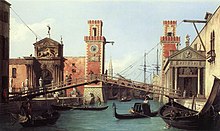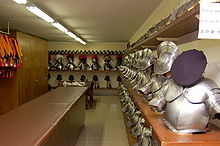Arsenal
This article needs additional citations for verification. (September 2014) |





An arsenal is a place where arms and ammunition are made, maintained and repaired, stored, or issued, in any combination, whether privately or publicly owned. Arsenal and armoury (British English) or armory (US spelling[1][2]) are mostly regarded as synonyms, although subtle differences in usage exist.
Sub-armory is a place of temporary storage or carrying of weapons and ammunition, like any temporary Post or patrol vehicle which is only operational in certain times of the day.[3]
Etymology
From Template:Lang-it, and Template:Lang-fr, from Template:Lang-ar, dār aṣ-ṣināʕa, meaning "manufacturing shop".[4][5][6][7][8][9]
Types
A lower-class arsenal, which can furnish the materiel and equipment of a small army, may contain a laboratory, gun and carriage factories, small-arms ammunition, small-arms, harness, saddlery tent and powder factories; in addition, it must possess great store-houses. In a second-class arsenal, the factories would be replaced by workshops. The situation of an arsenal should be governed by strategic considerations. If of the first class, it should be situated at the base of operations and supply, secure from attack, not too near a frontier, and placed so as to draw in readily the resources of the country. The importance of a large arsenal is such that its defences would be on the scale of those of a large fortress.
Operational subdivision
The usual subdivision of branches in a great arsenal is into storekeeping, construction and administration.
- Under storekeeping we should have the following departments and stores: Departments of issue and receipt, pattern room, armoury department, ordnance or park, harness, saddlery and accoutrements, camp equipment, tools and instruments, engineer store, timber yard, breaking-up store, unserviceable store.
- Under construction: Gun factory, carriage factory, laboratory, small-arms factory, harness and tent factory, powder factory, etc. In a second-class arsenal there would be workshops instead of these factories.
- Under the head of administration would be classed as the chief director of the arsenal, officials military and civil, non-commissioned officers and military artificers, civilian foremen, workmen and laborers, with the clerks and writers necessary for the office work of the establishments.
In the manufacturing branches are required skill, and efficient and economical work, both executive and administrative; in the storekeeping part, good arrangement, great care, thorough knowledge of all warlike stores, both in their active and passive state, and scrupulous exactness in the custody, issue and receipt of stores. Frederick Taylor introduced command and control techniques to arsenals, including the U.S.'s Watertown Arsenal (a principal center for artillery design and manufacture) and Frankford Arsenal (a principal center for small arms ammunition design and manufacture).
See also
- Armorer
- Dresden Armory
- Halifax Armoury
- Harpers Ferry Armory
- Kremlin Armoury
- Royal Arsenal (UK)
- Royal Armouries (UK)
- Springfield Armory
- Zeughaus (Berlin)
- Magazine (artillery)
References
- ^ Soanes, Catherine and Stevenson, Angus (ed.) (2005). Oxford Dictionary of English, 2nd Ed., revised, Oxford University Press, Oxford, New York, p. 85. ISBN 978-0-19-861057-1.
- ^ The English barrister and heraldist Arthur Charles Fox-Davies meant that the spelling without a u was never used for weapons but only used for armory in the meaning of the science of coats of arms, which is a part of heraldry, in his book The Art of Heraldry: An Encyclopædia of Armory (1904), p. 1
- ^ Firearms, Idaho Department of Correction, 2010, p. 2, retrieved 2014-06-12
- ^ "Definition of arsenal – Oxford Dictionaries (British & World English)". Oxford Dictionary of English.
- ^ "Define Arsenal at Dictionary.com". Reference.com.
- ^ "American Heritage Dictionary Entry: arsenal". The American Heritage Dictionary of the English Language.
- ^ "Online Etymology Dictionary". Online Etymology Dictionary.
- ^ "Definition of "arsenal" – Collins English Dictionary". Collins English Dictionary.
- ^ "Arsenal – Definition and More from the Free Merriam-Webster Dictionary". Merriam-Webster.
